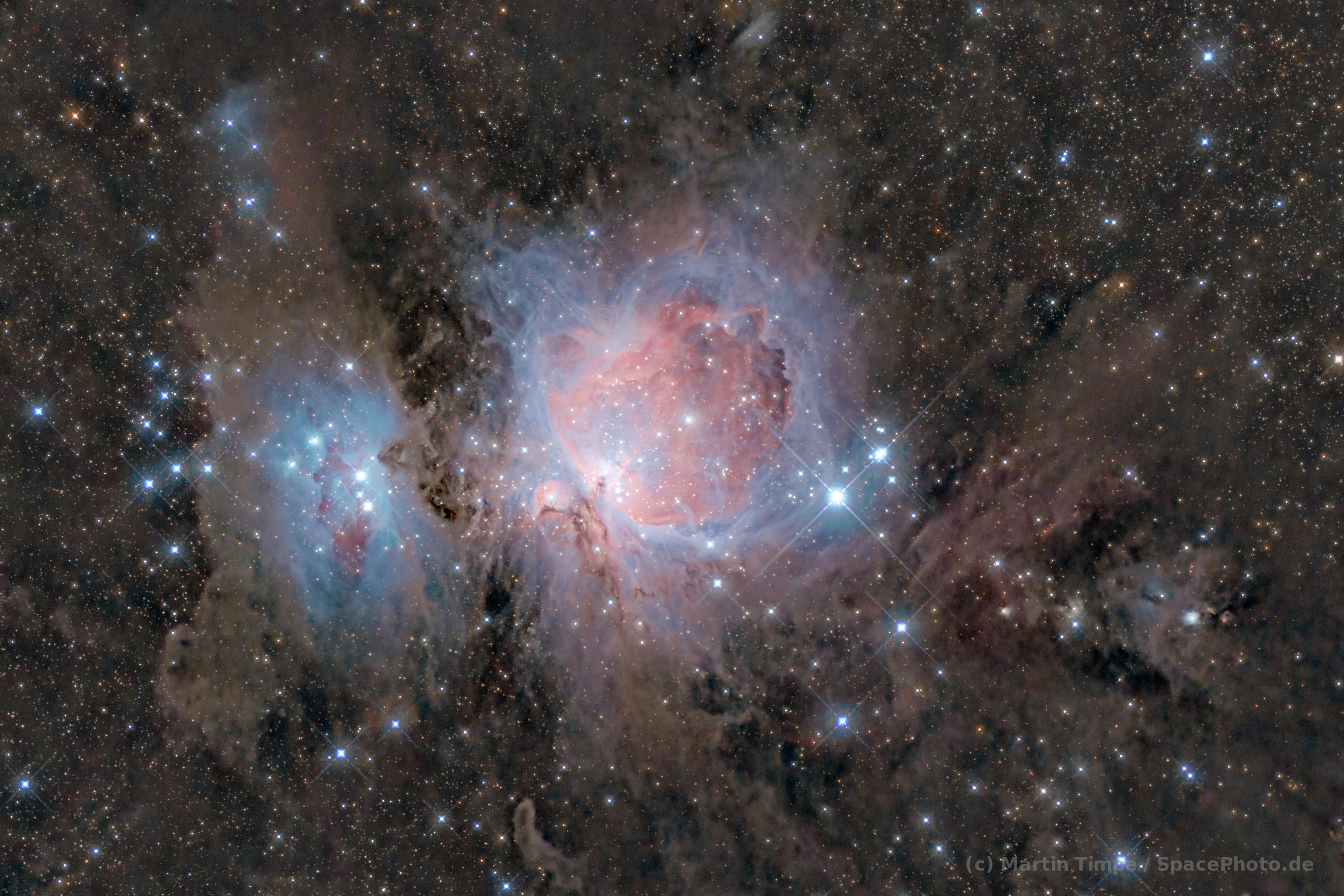M 42 The Orion Nebula and Neighbors
The celestial region shown in the image comprises the surroundings of the Large Orion Nebula. Most of the objects visible in the photographs are located in the Orion arm of the Milky Way, as is our home solar system.

HDR image section of the Orion Nebula with surroundings, telescope Newton 130mm f/3.3, camera Canon EOS 6Da ISO800, 60x180s 10x: 60s, 30s, 10s, 5s
The Orion Nebula is a subregion of the interstellar molecular cloud OMC-1 in the Orion Molecular Cloud Complex. The nebula consists mainly of hydrogen, within which new stars are formed whose ionising radiation stimulates the nebula to emit radiation in the visible spectral range. The main ionisation source of the Orion Nebula is the multiple star system "Theta1 Orionis C" (label: 41 the01 Ori) with the two components C1 and C2, which in turn appears as one of the four known Trapezium stars (Theta1 Orionis A-D), which are not fully resolved here due to the large magnification of the image (but the trapezium can be guessed). The luminosity of 41 the01 Ori C1 is a blue giant of approx. 34 solar masses and with an absolute brightness in the visible spectrum of -3.2 magnitudes. spectrum of -3.2 magnitudes, it is one of the brightest known stars. The distance between the Orion Nebula and our solar system is approx. 1350 light years. New stars are forming within the Orion Nebula. About one minute of arc of 41 the01 Ori can be seen (but only in the infrared wavelength range) the Becklin-Neugebauer object, named after its discoverers in 1965 which radiates at 700K and could be classified as a protostar. After further research in the early 1990s, the Hubble Space Telescope was able to discover several star systems in the process of formation, so-called proplyds. so-called proplyds (derived from the English term "protoplanetary disk").
While the Orion Nebula (catalogue designations M 42 or NGC 1976) is itself an emission nebula, the overview image also shows refexion nebulae such as VdB42 and VdB_44, NGC_1999 and numerous dust clouds.
The photo was taken shortly before the new moon on two nights on 8 and 9 January 2024 under very good visibility conditions (apart from the Christmas lights on neighboring buildings) and at very cold temperatures for Bad Kreuznach of -8°C or locally below. During processing, the astro-modified, second-hand Canon EOS 6Da camera unfortunately produced clear artefacts at the edges (which were not caused by flats, bias or calibration), so that the image had to be slightly cropped again. Unfortunately, the focus point was also not optimised, as the Lacerta MFOC firmware of the handbox (as countless times before) regularly crashed for reasons yet unknown to me and made focussing at -8° C a pain.
- Exposure Data:
Telescope: Corrected Newton, f=430mm, f/3.3
Camera Canon EOS 60Da ISO800
- Exposure Times
60x180s
10x60s
10x30s
10x10s
10x5s
Total: 3h 17 min 30s
Date: 09-11.01.2024
Location: Bad Kreuznach / Germany
Mount Skywatcher EQ8R-pro / Pegasus Astro EQMod
Guiding and Exposure Control with INDI / PHD2 / CCDCiel running on XUbuntu Linux
Image Processing PixInsight and Darktable

